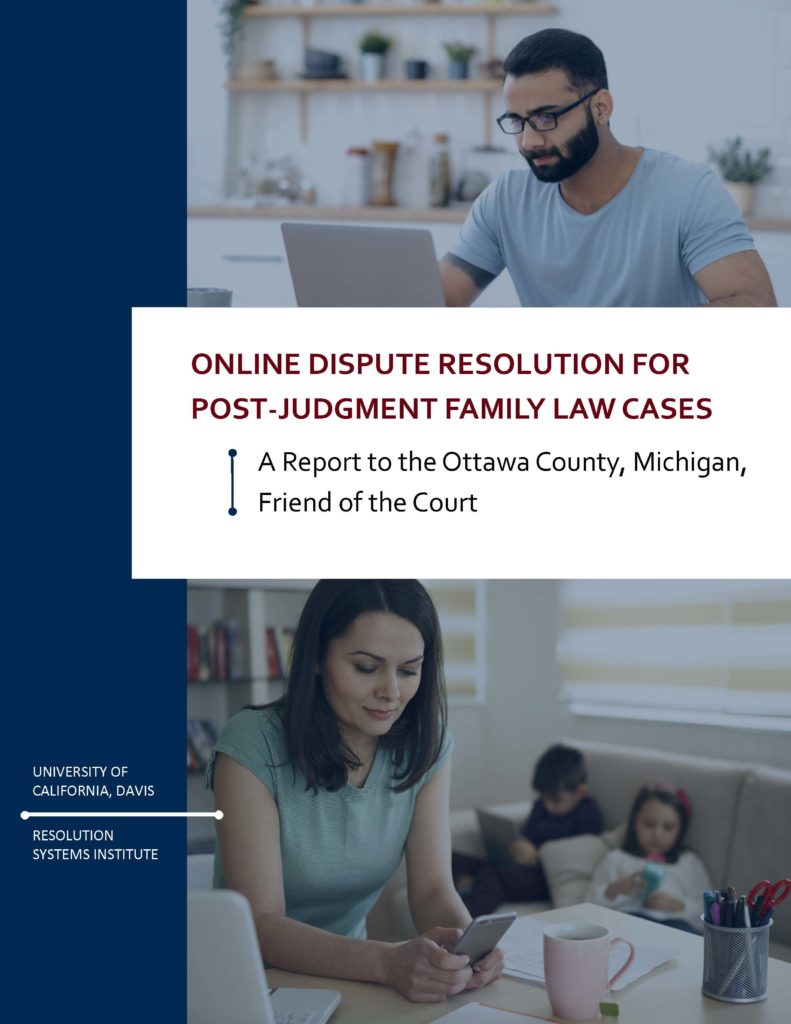University of California, Davis, Professor Donna Shestowsky and I recently had the pleasure of conducting the first neutral evaluation of any family law court online dispute resolution (ODR) program in the United States. The program was launched by the 20th Circuit of Michigan’s Friend of the Court (FOC) in August 2020 with the goal of providing parties with post-judgment family law disputes a simpler, more convenient and cost-effective way to reach agreements related to child custody, parenting time and child support. It also aimed to increase efficiency in the disposition of these matters. By and large, we found that the program was providing the benefits the FOC hoped it would.
What We Studied
The FOC used Matterhorn’s text-based ODR platform, which allows participants to communicate with each other and their caseworker via asynchronous text messages and document exchanges. We used case data, ODR data, pre- and post-process party surveys, and staff interviews to gain insight into:

- Parties’ expectations for the ODR process at the time it was offered to them, and their views on a video mediation alternative
- ODR access, including the percentage of parties who participated and opted out, information about ODR available to parties, and parties’ capacity to use ODR
- Participants’ evaluation of their experience of ODR in terms of procedural justice, satisfaction, fairness of the process, and ability to control the outcome of their matter
- Parties’ impressions of the FOC and the other party
- The agreement rates, hearing rates, and efficiency (time to disposition, caseworker time spent on matters) associated with ODR use
- Direct costs and the FOC’s staff members’ perceptions of the effect of ODR on their work
Excitement and Anxiety
We found that before ODR, parties tended to be confident they could reach agreement, but the majority did not believe the other party would be truthful. They expressed high levels of excitement about using ODR, but also high levels of anxiety. Those who were planning on using it were twice as likely to report a high level of fear of the other party as those who weren’t sure they would, or who were not going to, use ODR.
Because of the platform’s technological limitations, caseworkers did not offer ODR to parties who had attorneys, those who had limited English proficiency, or to those who were blind or visually impaired. In addition, the FOC had decided that those who had a history of a high level of conflict would not benefit from ODR, and they were therefore not offered the opportunity.
Uptake Higher than for Other ODR
Almost half of the parties who were offered the chance to use ODR did so, which was high compared with other early ODR programs, which have had participation rates of 21% to 36%. In half the cases in which ODR was offered but not used, at least one of the parties simply did not register to use it despite the FOC’s intent to require its use. We noted that the emails sent to the parties informing them to register for ODR used language that could have confused the parties both about what the program was and their requirement to participate. We also found that parties lacked an understanding of the main features of the program. This, too could have reduced program use.
A surprising finding was that almost all parties who used ODR accessed the platform with their mobile phone at least part of the time. Only 8% exclusively accessed the platform with a computer, while 71% only used their mobile phone. This indicates that the platform and any auxiliary activities, such as communications to the parties and agreement forms, must be optimized for phones.
When parties used ODR, they were four times as likely to give high ratings for fairness of the process as those who did not use ODR (50% vs. 12.5%), and twice as likely to give high ratings for satisfaction (50% vs. 25%). They were also much more likely to reach agreement than those who were offered ODR but didn’t use it (59% vs. 11%). In cases involving child support, parties using the online platform reached resolution nearly twice as fast as those who did not.
Positive, with Room for Improvement
Our evaluation indicates that the FOC’s ODR program has provided parties with a positive experience, improves agreement rates and reduces time to resolution for some cases. Program use is high in comparison with other programs.
However, our analysis suggests that the FOC could do more to educate parties about the program, direct parties to use it, and increase access to parties with disabilities as well as those who need an interpreter’s assistance to use the platform. The FOC should also explore ways to reduce access barriers for those identified by caseworkers as less likely to use or benefit from the program because they have lawyer representation or have high-conflict relationships. Attempts to reduce access barriers should also be directed at those who lack digital literacy and those who would use their mobile phone to access the platform. Our evaluation was limited by a small survey and case data sample size, which may have obscured statistical significance of some findings and did not allow us to conduct more detailed analyses of participant experience. We are looking forward to seeing more evaluations of ODR programs conducted, to build on our findings.


I assume this was MI…only “20th Circuit” noted.
Thank you, Kent! You are correct, and we have updated the post.